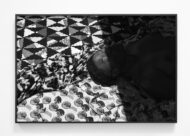The 12 photographs in Keisha Scarville’s solo show at Higher Pictures Generation seem to marry opposites: black and white, figurative and abstract, legible yet enigmatic. They show mainly pieces of richly patterned fabrics and parts of bodies, but nothing appears complete. In “Negotiating/Maneuver (5)” (2021), a woman’s face is obscured below her eyes by a line of shadow (and her body further cut off by the frame). At the edge of “Within/Between/Corpus (3)” (2021), fingers touch what seems to be a leg, but they provide only a small identifiable reprieve amid a sea of cloth.
Scarville is a Brooklyn-born, Guyanese-American photographer whose work often takes up, in poetic ways, her family heritage. It’s fitting that this exhibition is titled “Li/mb” — both because of the arms and legs pictured and because of her interest in the Caribbean limbo dance, which may have originated on the slave ships of the Middle Passage. In the gallery, two sculpted hands hold an outstretched rope near the ground; above them hangs “Within/Between/Corpus (1)” (2020), a photograph that features another photograph, of a Black woman and child, at its center. To limbo is to bend yourself to pass through a series of increasingly constrictive challenges. The installation suggests that this skill may be an inheritance in Black families.
More than scenes or objects, Scarville’s charged photographs seem to represent a state of being. Limbo can mean confinement but also something more metaphysical: a sense of being in transition, never one thing or the other but always in between.

